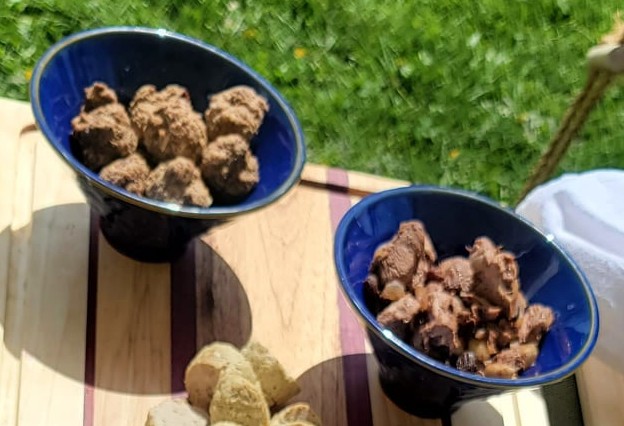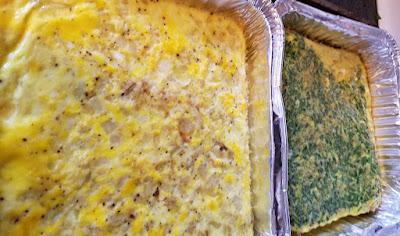One of the things I wanted to do when requested to put together the vigil table was to make sure that there was a little something for everyone from the savory to the sweet. For the carnivores I planned on offering a selection of meats; smoked pork, sausages made of pork, and pork and beef, chicken and meatballs of beef. I wanted to make sure that everything was bite size. In the past I have used meatballs to "round out" a course. They are inexpensive and easy to make and if you use a tablespoon measure, you can get approximately 30 meatballs for a pound of meat. In this case, I was able to get more meatballs because of the addition of the bread. My original intention was to roll them out into a log shape, but I served them up as balls instead. They were delicious with the
spicy brown mustard,
cherry sauce and
Käeßsuppen. Original German (
Ein New Kochbuch by Marx Rumpolt)
Ochsen 67. Knödel zu kochen auff ein andere manier von Rindtfleisch. Nim~ Rindtfleisch/ schneidt es klein/ vn~ klaub das Fett darvon/ hack es klein durcheinder/ nim~ ein wenig gestossen Pfeffer/ gerieben Saffran/ vnd ein wenig Saltz/ auch drey oder vier Eyer/ weich ein beschnitte~ Weck oder Sem~el eyn/ druck sie wol mit den Händen auß/ vnd hacks vnter das Fleisch/ thu saubere groß vnd kleine schwartze Rosein darvnter/ mach runde oder lenglichte Knödel darauß/ wie es dir wirt gefallen/ mach Butter heiß/ vnd rößt die Knödel darinnen fein langsam/ daß sie fein braun/ vnd nicht schwartz werden. Vnd wenn du sie hast außgerößt/ so thu sie in einen gekochten Pfeffer/ der wol
English Translation: (by M. Grasse)Beef #67: Meatballs of beef to cook in another manner. Take beef/ and cut it small/ and trim the fat away/ hack (mix) it small and together/ take a little pounded pepper/ rubbed saffron/ and a little salt (salz in German)/ also three or four eggs/ soak a trimmed loaf or roll/ press (the liquid) out well with the hands/ and hack (mix) under the meat/ put clean large and small black raisins thereunder/ make (form) round or longish dumplings (meatballs) therefrom/ as it pleases you/ heat butter/ and slowly fry the meatballs therein/ that they become fine brown/ and not black. And when you have cooked them through/ put them in a cooked pepper/ that well testing and fixed is/ let them come to a boil again in the pepper/ so it is well tasting/ a good meal for poor and rich.
RECIPE:
1 pound ground beef (80/20)
1 tsp. black pepper
2 tsp. salt
4 eggs
1 c. bread crumbs soaked in water or milk
¾ c raisins (you can vary this to taste)
Please Note: I deviated from the recipe by boiling the meatballs in broth instead of frying.
Mix all ingredients together adding water until the meat forms a paste. Divide meat into portions and roll into shape (balls or logs as you desire). If you are following the recipe, you will want to brown the meatballs in some fat in a pan.
If you want to follow my shortcut, season some broth with the seasonings below (vinegar, black pepper, ginger), drop the meatballs in and cook a small batch at a time until they float. Once they float, they can be removed, cooled and frozen until needed.
I cannot claim the black pepper sauce recipe. This is hosted on "
The Inn at the Crossroads" website. Another resource I like to use. Their recipe is below:
Poivre Noir : Black Pepper SauceORIGINAL RECEIPT:
165. Poivre noir: Black Pepper Sauce. Grind ginger, round pepper and burnt toast, infuse this in vinegar (var.: and a little verjuice) and boil it. – Le Viandier de Taillevent, 14th century
Ingredients
1 slice bread, toasted until black
1/3 cup verjuice, or equal parts cider vinegar and water
1 Tbs. wine vinegar
1 Tbs. ground black pepper
1/4 tsp. ground ginger
Soak the burned bread in the liquid until it has fallen apart; mash with a fork. Stir in the spices and slowly bring to a boil. For a thinner sauce, add more liquid; for a smoother version, press through a sieve.




